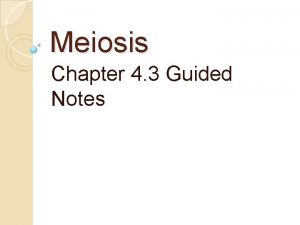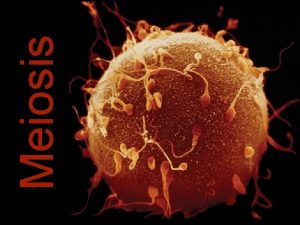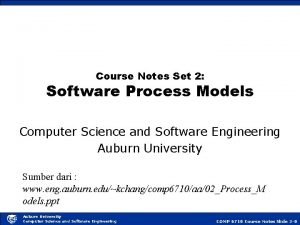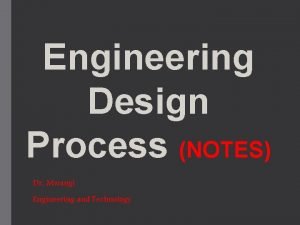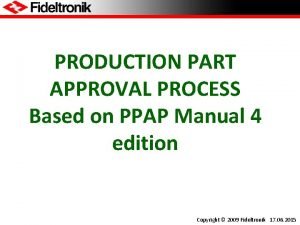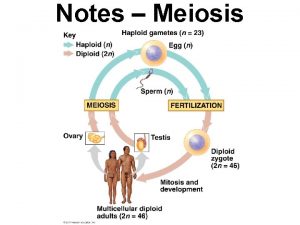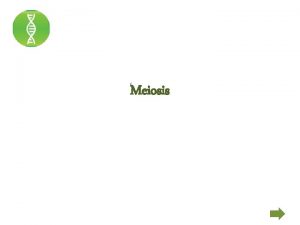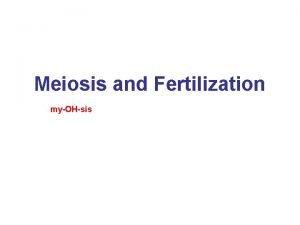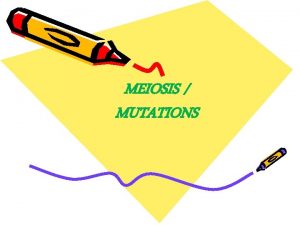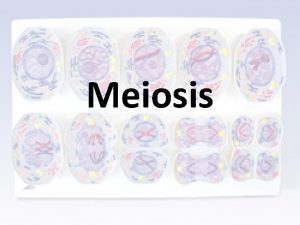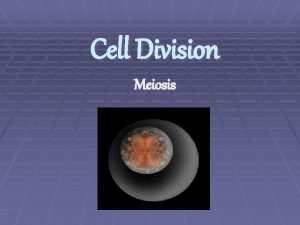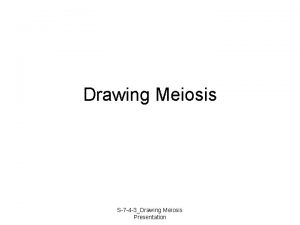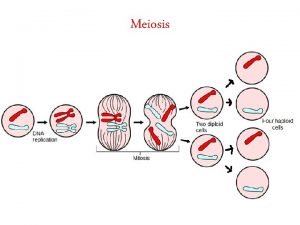Meiosis Notes Part 2 I Meiosis A Process
























- Slides: 24

Meiosis Notes- Part 2

I. Meiosis A. Process of “reduction division” in which the chromosome number is cut in half to make genetically different gamete cells.

B. Two divisions- Meiosis I and Meiosis II C. PURPOSE – make cells for REPRODUCTION D. Starts with diploid cell from the reproductive organ (ovary or testes) E. Prior to Meiosis I, chromosomes replicated during interphase of the cell cycle.

II. Meiosis

1. PROPHASE I a. Nucleus disappears b. Spindle fibers form c. Chromatin begins condensing to form visible chromosomes d. Crossing over of homologous chromosomes occurs e. Tetrads form

i. Prophase I is almost identical to mitosis EXCEPT: - Homologous chromosomes pair up to form a tetrad - Crossing Over –portions of genetic info is exchanged between non-sister chromatids of homologous chromosomes This allows for more genetic variation within the species.

2. Metaphase Ia. tetrads line up in middle of cell b. Spindle fibers attach to centromere of tetrad NOTICE HOW NO TWO STRANDS ARE ALIKE!!

3. Anaphase I – a. Homologous Chromosomes move apart toward centrioles b. Cytokinesis begins

4. Telophase Ia. Nuclear membrane reappears b. Spindle fibers break down c. Chromosomes begin uncoiling back to chromatin 5. Cytokinesis I-(not part of meiosis) a. Cytoplasm finishes pinching in b. After cytokenisis finishes. Two cells have formed c. Chromosomes no longer visible, only chromatin. (Both Cells are genetically different from the parent cell, and each other due to crossing over).

1. Cytokinesis I goes directly into Meiosis II Compared to Mitosis and meiosis I…what phase of the cell cycle is skipped? INTERPHASE What is significant about the lack of this phase? *hint- think about what happens in the S phase CHROMOSOMES ARE NOT REPLICATED!

III. Meiosis II –No DNA Replication! A. Both cells entering meiosis II have chromosomes with 2 chromatids (like in mitosis-except they are genetically different).

1. PROPHASE II a. Nuclear envelope disappears b. Centrioles separate c. Spindle fibers form d. Chromatin begins condensing to form visible chromosomes

2. METAPHASE II a. Chromosomes line up in middle of cell b. Spindle fibers attach to centromere of chromosomes

3. ANAPHASE II a. Chromatids separate (move apart/away) becoming individual chromosomes. b. Cytokenisis begins

4. Telophase II a. Nuclear membrane reappears b. Spindle fibers break down c. Chromosomes begin uncoiling back to chromatin 5. Cytokinesis II- not part of meiosis) ( a. Cytoplasm finishes pinching in. b. chromosomes no longer visible, only chromatin

**After cytokinesis II finishes-Four haploid cells have formed!

f. End result: 4 genetically different gametes with the haploid (N) number of chromosomes, for reproduction!

IV. Male Gamete Formation A. Four haploid cells formed B. Humans 1. Takes place in testes 2. Begins at puberty 3. Continues for lifetime

V. Female Gamete formation A. Four haploid cells formed 1. One egg -receives most of the cytoplasm(nutrients) 2. Three Polar bodies (cells that didn’t get enough nutrients to become an egg. B. HUMANS 1. Takes place in ovaries before birth. 2. Pauses then continues at puberty with menstrual cycle until menopause

FEMALE GAMETE FORMATION

M 1 P 1 A 1 T&C 1

P 2 A 2 M 2 T&C 2

• Amoeba Sisters Meiosis

FEATURE Type of Cell Mitosis vs. Meiosis Number of Cells produced End Product Number of chromosomes MITOSIS MEIOSIS somatic Gamete 2 4 Two identical body cells 4 genetically different gametes Same as original cell (Diploid) Half of original cell (Haploid)
 Disvantages of sexual reproduction
Disvantages of sexual reproduction Tetrad meiosis
Tetrad meiosis Meiosis and genetic variation answer key
Meiosis and genetic variation answer key What is the difference between mitosis and meiosis 2
What is the difference between mitosis and meiosis 2 Chapter 10 section 1: meiosis
Chapter 10 section 1: meiosis Chapter 10 section 1 meiosis
Chapter 10 section 1 meiosis Prohase 2
Prohase 2 Meiosis flipbook
Meiosis flipbook Functions of meosis
Functions of meosis Cube wisc
Cube wisc Fahrenheit 451 section 3 summary
Fahrenheit 451 section 3 summary Part part whole addition
Part part whole addition Unit ratio definition
Unit ratio definition Brainpop ratios
Brainpop ratios What is a technical description
What is a technical description 3 parts of the bar
3 parts of the bar The part of a shadow surrounding the darkest part
The part of a shadow surrounding the darkest part Two way anova minitab 17
Two way anova minitab 17 Meiosis 1 and 2 diagram
Meiosis 1 and 2 diagram Software process model class 12 notes
Software process model class 12 notes Process design notes
Process design notes Writing process notes
Writing process notes Solvay process notes
Solvay process notes Product disassembly
Product disassembly Significant production run
Significant production run








